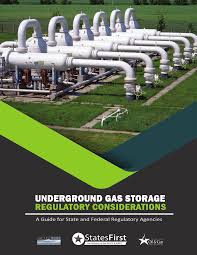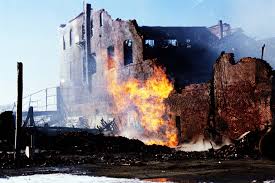
A national Natural Gas Storage Work Group has released a report on underground gas storage that evaluates potential vulnerabilities at gas storage operations and identifies prospective regulatory responses for consideration by state and federal agencies.
Most underground gas storage facilities have safe histories of operation and allow large supplies of gas to be stored during times of low demand, and withdrawn from storage when demand for natural gas is high; thereby reducing the need for larger transmission pipelines and allowing for continuous supply of gas in the event of supply interruptions. However, when an accident occurs it can have dramatic impacts to public health, safety and the environment.
Two of the most serious occurred at the Moss Bluff storage facility in Texas and the Yaggy storage field in Kansas. The Moss Bluff facility was a salt cavern storage operation. In August 2004, casing in one of the wells failed, resulting in a large release of gas and an uncontrolled fire lasting for more than six days.

The Yaggy incident involved a wellbore failure which led to a series of gas explosions in Hutchinson, Kansas. The explosions and fire damaged 26 businesses and caused two deaths.
Most recently, there was a serious underground leak at the Aliso Canyon gas storage facility near Los Angeles, California. The leak began in October 2015 and continued for almost four months before it was controlled. It is characterized as the worst natural gas leak in U.S. history, and resulted in the evacuation
of about 4,000 homes in the area.
The work group, which was led by states from across the country and was organized by the Interstate Oil and Gas Compact Commission and Ground Water Protection Council, developed the report “Underground Gas Storage Regulatory Considerations” to serve as a resource for regulatory agencies and includes input from experts in academia, industry, non-profit organizations, and other state and federal agencies.
Underground storage of natural gas is a critical element in the U.S. energy supply and distribution system and plays an essential role in maintaining the reliability of natural gas supplies and ensuring stable prices for consumers, according to the report.
The 130 page report addresses the regulatory framework of underground gas storage, risk management, state permitting, well drilling and construction, well integrity, reservoir integrity, monitoring, and emergency response planning among other topics.
“A lot of thought and expertise went into this report,” said Hal Fitch, Work Group co-chair and division director for Michigan’s Oil, Gas, and Minerals Division, Department of Environmental Quality. “We believe it will be a great resource for state and federal agencies as they work to enhance their oversight of gas storage in the U.S.”
To read or download full report, click this link.





